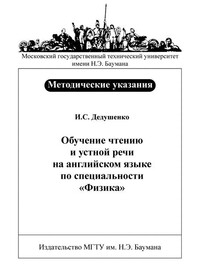Обучение чтению и устной речи на английском языке по специальности «Физика»
Покупка
Тематика:
Английский язык
Автор:
Дедушенко Ирина Семеновна
Год издания: 2012
Кол-во страниц: 52
Дополнительно
Вид издания:
Учебно-методическая литература
Уровень образования:
ВО - Бакалавриат
Артикул: 840501.01.99
В каждом из трех уроков содержатся словарь, три текста и задания, позволяющие контролировать понимание текстов. Грамматические упражнения направлены на повторение наиболее сложных конструкций английского языка.
Для студентов старших курсов, обучающихся по специальности «Физика» (кафедра ФН-4).
Тематика:
ББК:
УДК:
ОКСО:
- ВО - Бакалавриат
- 00.03.38: Физика
- 03.03.01: Прикладные математика и физика
- ВО - Специалитет
- 03.05.02: Фундаментальная и прикладная физика
ГРНТИ:
Скопировать запись
Фрагмент текстового слоя документа размещен для индексирующих роботов
Московский государственный технический университет имени Н.Э. Баумана И.С. Дедушенко Обучение чтению и устной речи на английском языке по специальности «Физика» Методические указания Москва Издательство МГТУ им. Н.Э. Баумана 2012
УДК 802.0
ББК 81.2 Англ-923
Д26
Рецензент И.В. Стасенко
Дедушенко И.С.
Обучение чтению и устной речи на английском языке
по специальности «Физика» : метод. указания / И.С. Дедушенко. — М.: Изд-во МГТУ им. Н.Э. Баумана, 2012. —
49, [3] с.
В каждом из трех уроков содержатся словарь, три текста и задания, позволяющие контролировать понимание текстов. Грамматические упражнения направлены на повторение наиболее сложных
конструкций английского языка.
Для студентов старших курсов, обучающихся по специальности
«Физика» (кафедра ФН-4).
УДК 802.0
ББК 81.2 Англ-923
МГТУ им. Н.Э. Баумана, 2012
Д26
ПРЕДИСЛОВИЕ Данные методические указания предназначены для обучения студентов-физиков старших курсов чтению, переводу научно-технической литературы на английском языке, навыкам реферирования и аннотирования, а также умению дискутировать на профессиональные темы. Перед чтением основного текста урока рекомендуется ознакомиться с предваряющим текст вокабуляром. Усвоение терминов облегчает дальнейшее беспереводное понимание текстов. Любая работа с текстом должна начинаться с просмотрового чтения, а не с дословного перевода. В разделе Discussion даны задания на понимание текста и применение материалов урока при обсуждении проблем по физике. Этот раздел очень важен для обучения студентов навыкам устной речи, умению анализировать материал и логически строить ответ. Эти навыки и умения позволят студенту подготовиться к презентации доклада на конференции, а также с легкостью вести беседу на профессиональную тему и обсуждать научные проблемы. Грамматические упражнения составлены таким образом, что обеспечивают повторение наиболее сложных конструкций английского языка, таких, как образование множественного числа существительных латинского и греческого происхождения, неличные формы глагола. Предложенный грамматический материал необходим для правильного перевода статей по физике, а также для ведения научной беседы. Методические указания помогут будущим специалистам в области физики лучше ориентироваться в огромном потоке публикаций на английском языке, определять их ценность и постоянно повышать свой профессиональный уровень.
Unit 1. THREE NEWTON’S LAWS Memorize the following vocabulary to text 1A. center-of-mass acceleration — центр инерционной массы conversion n — превращение, преобразование, переход converse v — преобразовывать exert v — прилагать усилия, напрягать силы downward force — сила, направленная вниз total force — результирующая (полная, суммарная) сила upward force — подъемная сила; сила, направленная вверх let down v — опускать, спускать; ослаблять, замедлять, снижать negligible adj — ничтожный, не принимаемый в расчет on the order of — порядка … pull up v — натягивать side-effect — побочный эффект speed up v — ускорять stick, stuck v — задерживать, останавливать streamlined adj — обтекаемый, четкий taper off v — сужаться, убывать по конусу terminal velocity — конечная скорость vanquish v — преодолевать, побеждать velocity n — 1. скорость; 2. вектор скорости weigh v — взвешивать weight n — вес
Text 1A. Newton’s First Law Read and translate the text. Study the examples given in the text. If the total force on an object is zero, its center of mass continues in the same state of motion. In other words, an object initially at rest is predicted to remain at rest if the total force on it is zero, and an object in motion remains in motion with the same velocity in the same direction. The converse of Newton’s first law is also true: if we observe an object moving with constant velocity along a straight line, then the total force on it must be zero. What happens if the total force on an object is not zero? It accelerates. For example: An elevator has a weight of 5000 N. Compare the forces that the cable must exert to raise it at constant velocity, lower it at constant velocity, and just keep it hanging. Answer: In all three cases the cable must pull up with a force of exactly 5000 N. Most people think you’d need at least a little more than 5000 N to make it go up, and a little less than 5000 N to let it down, but that’s incorrect. Extra force from the cable is only necessary for speeding the car up when it starts going up or slowing it down when it finishes going down. Decreased force is needed to speed the car up when it gets going down and to slow it down when it finishes going up. But when the elevator is cruising at constant velocity, Newton’s first law says that you just need to cancel the force of the earth’s gravity. It seems that the statement in the example that the cable’s upward force “cancels” the earth’s downward gravitational force implies that there has been a contest, and the cable’s force has won, vanquishing the earth’s gravitational force and making it disappear. We know that both forces continue to exist because they both have side-effects other than their effects on the car’s centre-of-mass motion. That is incorrect. Both forces continue to exist, but because they add up numerically to zero, the elevator has no center-of-mass acceleration. The force acting


